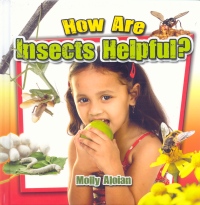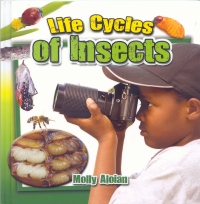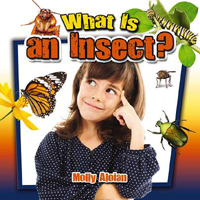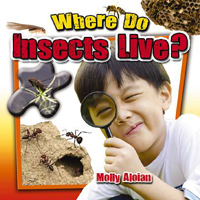| ________________
CM . . .
. Volume XX Number 16. . . .December 20, 2013 
 |
How Are Insects Helpful? (Insects Close-Up).
Molly Aloian.
St. Catharines, ON: Crabtree, 2014.
24 pp., pbk., hc., pdf & html, $8.95 (pbk.) $18.36 (RLB.).
ISBN 978-0-7787-1281-7 (pbk.), ISBN 978-0-7787-1269-5 (RLB.), ISBN 978-1-4271-9363-6 (pdf), ISBN 978-1-4271-8959-2 (html).
Subject Headings:
Insects-Juvenile literature.
Edible insects-Juvenile literature.
Insects-Ecology-Juvenile literature.
Kindergarten-grade 2 / Ages 5-7.
Review by Gail Hamilton.
*** /4
|
| |
|
 |
Life Cycles of Insects. (Insects Close-Up).
Molly Aloian.
St. Catharines, ON: Crabtree, 2014.
24 pp., pbk., hc., pdf & html, $8.95 (pbk.) $18.36 (RLB.).
ISBN 978-0-7787-1282-4 (pbk.), ISBN 978-0-7787-1278-7 (RLB.), ISBN 978-1-4271-9364-3 (pdf), ISBN 978-1-4271-9360-5 (html).
Subject Headings:
Insects-Development-Juvenile literature.
Insects-Life Cycles-Juvenile literature.
Kindergarten-grade 2 / Ages 5-7.
Review by Gail Hamilton.
*** /4
|
| |
|
 |
What Is an Insect? (Insects Close-Up).
Molly Aloian.
St. Catharines, ON: Crabtree, 2014.
24 pp., pbk., hc., pdf & html, $8.95 (pbk.) $18.36 (RLB.).
ISBN 978-0-7787-1283-1 (pbk.), ISBN 978-0-7787-1279-4 (RLB.), ISBN 978-1-4271-9365-0 (pdf), ISBN 978-1-4271-9361-2 (html).
Subject Heading:
Insects-Juvenile literature.
Kindergarten-grade 2 / Ages 5-7.
Review by Gail Hamilton.
*** /4
|
| |
|
 |
Where Do Insects Live? (Insects Close-Up).
Molly Aloian.
St. Catharines, ON: Crabtree, 2014.
24 pp., pbk., hc., pdf & html, $8.95 (pbk.) $18.36 (RLB.).
ISBN 978-0-7787-1284-8 (pbk.), ISBN 978-0-7787-1280-0 (RLB.), ISBN 978-1-4271-9366-7 (pdf), ISBN 978-1-4271-9362-9 (html).
Subject Headings:
Insects-Habitat-Juvenile literature.
Insects-Habitations-Juvenile literature.
Kindergarten-grade 2 / Ages 5-7.
Review by Gail Hamilton.
*** /4
|
| |
|

excerpt:
Some insects make homes called burrows in underground habitats. Burrows are tunnels dug into the ground. Most insects that dig burrows are solitary insects. Solitary insects live alone. Certain types of beetles, crickets, and wasps are solitary insects.
Solitary insects make narrow burrows so predators cannot get in. Predators are animals that hunt and eat other animals. Solitary wasps are predators. They hunt other insects in their habitats. Once a wasp catches an insect, it brings the insect back to its burrow to eat. (From Where Do Insects Live?)
Insects comprise more than half of all the animals on Earth and serve a variety of purposes ranging from plant pollination to making honey. The new "Insects Close-Up" series focuses on the body parts, habitats and life cycles of insects as well as the important role that insects play in various eco-systems. Some of the information is repeated in each title, merely paraphrased. The text, printed in a large, simple font, consists of a few short sentences per page and is easy for youngsters to comprehend. Throughout the text there are "What do you think?" sections, each of which poses a question for readers. Some of the questions are very basic while others require a bit more consideration of the featured concept. The books' strength is mainly in the highly appealing colour close-up photographs. A table of contents, a "Words to Know" section, a brief index and a list of books and websites for further research are provided.
Insects are not only helpful to other living things, but they are also beneficial to the earth. How Are Insects Helpful? examines the various roles that insects play: they provide food for other animals, make honey and beeswax, spin cocoons from which silk threads are spun, help pollens and seeds travel, eat garden pests and decomposing plants and animals, and dig tunnels to keep the soil fertile. After reading this book, youngsters will gain a new-found appreciation for insects.
Life Cycles of Insects highlights the two types of metamorphosis, complete and incomplete, and shows the stages in each by means of diagrams and photos. The one flaw in this title is the use of the term "baby insects" when referring to eggs and larvae. This term could be potentially confusing to young children as insects in their early stages look nothing like their adult versions.
What Is an Insect? serves as a basic introduction to this animal group. In this title, readers will learn about insects' body parts, habitats, diet, and method of movement, the difference between a spider and an insect, and why insects are important. The flaw in this title is that it discusses the stages of complete metamorphosis, but omits the incomplete.
Insects can live in a variety of "homes": they can burrow underground, live above ground, in trees or in live or dead wood, in hives, nests and in or on water. Some, like honeybees, ants and termites, are social insects that live in large groups while others, such as the Jerusalem cricket, are solitary insects. The focus of Where Do Insects Live? is on the ways in which insects build their homes and how people can help to protect insects' habitats. One major omission from this title is the topic of migration, especially as it pertains to Monarch butterflies.
Generally, the "Insects Close-Up" series is a good beginning series that will be useful in a primary classroom.
Recommended.
Gail Hamilton is a former teacher-librarian in Winnipeg, MB.

To comment
on this title or this review, send mail to cm@umanitoba.ca.
Copyright © the Manitoba Library Association. Reproduction for personal
use is permitted only if this copyright notice is maintained. Any
other reproduction is prohibited without permission.
NEXT REVIEW |
TABLE OF CONTENTS FOR THIS ISSUE
- December 20, 2013.
AUTHORS |
TITLES |
MEDIA REVIEWS |
PROFILES |
BACK ISSUES |
SEARCH |
CMARCHIVE |
HOME |



